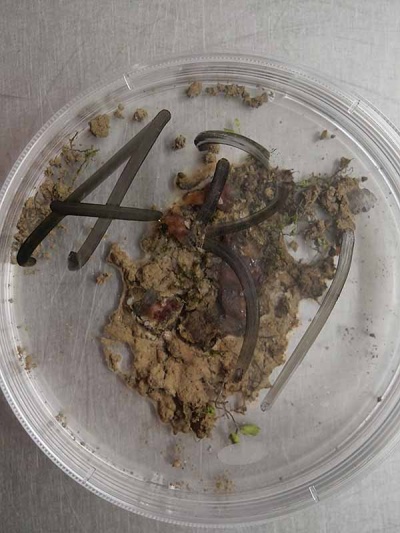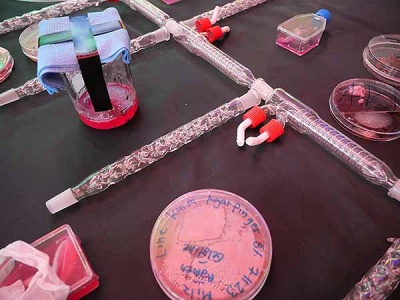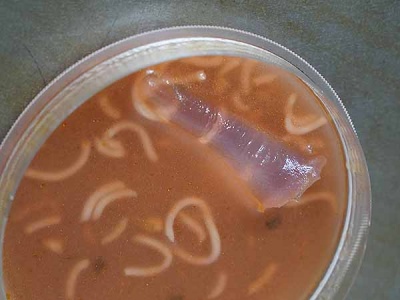Surf and Turf Tissue Culture BBQ
Contents
Hands-on Wetlab Bioart Workshop in Tissue Culture with Adam Zaretsky and Lyndsey Walsh
Surf and Turf Tissue Culture BBQ is a Bioart Wet Lab BioHackers Workshop introducing Tissue Culture for Artists and Non-scientists. This means we mix our theories with Hands-On Labwork. This is not science training, it is and experiential bioethics and bioart production studio doing the strange work of tissue culture. From preparing your own incubation environments and needed fluids to isolating and 'caring' for your tissue sample to end of life issues in tissue culture arts, this is a creative workshop.
Issues covered include: overview of the history and art history of tissue culture, the social, bioethical and pure hype dimensions of applications like: lab grown meat, bioart medical arts and engineering of artificial organs, medical tourism for stem cell therapy, reducing animal use in environmental toxicology and how to make transgenic embryonic stem cell clones by the millions.
Location: Hackteria ZET - Open Science Lab
Hackteria ZET - Open Science Lab, 3.Floor, Bitwäscherei, Neue Hard 12, 8005 Zürich, Switzerland
Since summer 2020 we have initiated a new local programme in Switzerland under the name «Hackteria – Zentrum für Experimentelle Transdisziplinarität» and we proudly started a new space, as part of Bitwäscherei shared hackerspace collective, with dedicated facilities for the «Open Science Lab». A laboratory, a social learning space, a place of work and research, a transdisciplinary meeting point for designers, hackers, artist, foodies and fermentation activitists.
Schedule
6 - 8. November 2023
Workshop: 14:00 - 19:00 Monday / Tuesday / Wednesday
If you can't do all three days, you are also welcome to participate a single afternoon (or two)
Public BBQ: 20:00 - 22:30 Tuesday, 7. Nov: BBQ & Participative Tissue Culture Performance
Registration
Please regsiter in advance to be informed of preparations and reserve your particpation!
For now... send an email to: dusjagr
Free prizing model to support the mentors, travel and material costs:
Full participation all three days: 120 CHF + donation (up to 250 CHF would be appreciated)
Join for 1 Day: 50 chf + donation
BBQ and performance: donation
Registration fee can be paid on site in cash or via Twint to 077 993 08 77.
Description
Day One
Tissue Culture Bioart - Introduction and Preparation
Monday November 6th 14 – 19h
This is the day to learn how to keep your working area clean and prepare your stock solutions. It is also an introduction to the lab and the implications of DIY Tissue Culture in the Bioart arena. This sounds basic but in an art context you have a change to try new materials and sterilize them for use in your experiment, creative powders and liquids can be invented and autoclaved for novel reagents. We are opening the range of theory and experimental design for tissue culture that is not for emulation of scientific research, but for semi-living/undead sculptures and disembodied new media play. It is also a time to consider a care plan for your cultured cells, including a turn towards understanding their non-human, non-organismic needs and desires.
Review:
1. Overview of Tissue Culture History (Alexis Carrol) and Hype 2. Overview of Tissue Culture Bioart History and Hype Including Uses and Future Hopes 3. And comparisons to live batches of fermenting done to byproducts using control of pH, contamination and food organisms like bacteria for yogurt, kimchee and pharmaceuticals or yeast for bread, beer, nutritional supplements.
We practiced and explained:
1. Aseptic Containment 2. Autoclaving (pressure cooking) 3. HEPA filter laminar flow hoods (clean air flow) 4. Preparing sterile surgical and microsurgical instruments 5. Filtering stock solutions (reagents) 6. BioSafety - Sharps and Biohazardous Waste 7. Creative experimental design 8. Animal Care and Use Committtees (AICUC) 9. lightly developed our personal care plans
We learned: 1. pipetting and measuring professionally 2. Mixing sterile DMEM (pH balanced media with electrolytes), PenStrep (antibiotics) and FBS (fetal bovine serum) Lyndsey lead with style!!!!
Day Two
Primary Cell Acquisition and Beginners Tissue Culture
Tuesday November 7th 14 – 19h
On this day we focus on primary cell acquisition and beginners tissue culture. This is Hands-on harvesting of bone marrow from cow beef cuts and also gonads, oogonia, spermatogonia, other tissue types and maybe sperm and eggs for embryo stem cells from local fish. We are using leftovers from food prep for the lab, not leftovers from the lab for food. Discussion on the difference between somatic and germ/germline tissue types, fermentation and drug development, co-culturing more than one kind of tissue, population genetics, colonies and incest in a dish
Trigger warning: anatomy autopsy and micro dissection is not for the faint of heart or the moral vegetarian. The yuck factor is 7.3 and so please join only with your own pre-knowledge of the reality of the gory scenario.
Plus, we eat what we use: Seafood and Steak (Surf and Turf) on the Barbie.
Review: We sculpted: 1. unusual sterile tissue culture scaffolds/constructs, 2. conceptual and experimental cellular vessels 3. and hand crafted melted glass micro-surgical tools.
Oron Cats did video in from the Tissue Culture and Art Project (TCA) in Perth, Australia https://tcaproject.net/
We had discussion with Kelly Ormond ABGC and EBMG Registered Genetic Counselor, Lecturer and Research Scientist, ETH-Zurich ETH Zurich Health Ethics & Policy Lab Department of Health Sciences and Technology, kelly.ormond@hest.ethz.ch bioethics.ethz.ch @HealthEthicsandPolicyLab @EthicsPolicyLab
The primary cell acquisition went well. There was no chicken autopsy or any testicles whatsoever (not horse, chicken or goat) but there was a lot of meats to choose from and we did see bone marrow cells, striated muscle tissue cells and globs of fat corpuscles on the Hackteria DIY webcam inverted microscope.
A wide variety of projects stacked the clean incubation and the dirty incubator.
One person did use their body to incubate overnight but their ass failed the care plan.
We had a haunted and super well decorated macabre séance dinner and a naughty, ephemeral and quite humorous exhibition. Big thanks to Kishana for vampyric ambiance design.
BBQ & Participative Tissue Culture Performance
plus Public BBQ: 20:00 - 22:30 Tuesday, 7. Nov
Day Three
Tissue Culture Contamination, Death and Mummification with Documentation Discussion Share Day
Wednesday November 8th 14 – 19h
This a day for sharing results. After a night of growth, for some of you using your bodies as strap-on incubators, we image our cultures through microscopy. We DITO (Do It TOgether) the process of changing the media or ‘passaging’ (cleaning the cellular cage/stage). We go over a real schedule for growing cells to keep them proliferating long enough for gross anatomy globs to appear visible by eye. We consider issues in archiving including actuated and personal Death Rituals for/of/on partial being. We also start an open discussion with the participants and the Hackteria Tissue Culture Open Working Group: lab reactions, future lab potentials, what gene editing or immortalizing your growing cell samples might produce and more.
This is followed by a reiteration of biosafety, including proper disposal or various kinds of mummification or preservation.
Review: We had some death rituals and some partial life, zombie pets were taken home for enrichment or burial. There are some tissue monsters still growing or dying or both, They are still in the incubator… Please describe style of execution for your undead biohazards if you would like them terminated for you.\
We also did not cover: 1. how to read scientific papers for non-scientists 2. the role of CO2 incubators in tissue culture or Do It Yourself CO2 incubator alternatives. 3. We didn’t play enough with the dada of experimental design: science as data and process art as conceptual practice. 4. the role of stem cells, embryonic stem cells and immortalized cell lines and their relation to germline genetic human genome editing or enhancement cloning transhumanism… we did not culture any newly fertilized cells of a growing zygote morula blastula gastrula neurula, etc. But, hint: embryos, organs, organoids, glands and more can also be cultured or kept on life support in various ways. Often involving perfusion pumps, pressurized soft chambers and some miniaturized ECMO spaces. 5. Biodegradable Polymers and 3D printing 6. Passaging - Let us know if you are planning a longer timed ‘keeping aliveness’ that includes passaging (or changing the vessel/flask adding fresh media, fresh food and medicine) as that was not taught: you may need trypsin which we have but which is dangerous to handle.
Mentors
Adam Zaretzky
Zaretsky is a Wet-Lab Art Practitioner mixing Ecology, Biotechnology, Non-human Relations, Body Performance and Gastronomy. Zaretsky stages lively, hands-on bioart production labs based on topics such as: foreign species invasion (pure/impure), radical food science (edible/inedible), jazz bioinformatics (code/flesh), tissue culture (undead/semi-alive), transgenic design issues (traits/desires), interactive ethology (person/machine/non-human) and physiology (performance/stress). A former researcher at the MIT department of biology, for the past 25 years Zaretsky has been teaching an experimental bioart class called VivoArts at: San Francisco State University (SFSU), SymbioticA (UWA), Rensselaer Polytechnic Institute (RPI), University of Leiden’s The Arts and Genomic Centre (TAGC) and with the Waag Society. He has also taught DIY-IGM (Do-It-Yourself Inherited Genetic Modification of the Human Genome) at New York University (NYU) and Carnegie Mellon University (CMU). He also runs a public life arts school: VASTAL (The Vivoarts School for Transgenic Aesthetics Ltd.) His art practice focuses on an array of legal, ethical, social and libidinal implications of biotechnological materials and methods with a focus on transgenic humans.
- http://www.emutagen.com/
- https://www.hackteria.org/projects/artist-in-residence-adam-zaretsky/
- https://thgap.hackteria.org
Lyndsey Walsh
Lyndsey Walsh is a US artist, writer, and researcher based in Berlin, Germany. Lyndsey has a Bachelor’s in Individualized Studies from New York University and a Master’s in Biological Arts with Distinction from SymbioticA Centre of Excellence in Biological Arts at the University of Western Australia. Lyndsey’s practice fuses speculative narratives and horror with autoethnographic investigations into the ruptures created by technology in the corporality of culture. Lyndsey sets out to question the cultural binaries of human-non-human, diseased-healthy, and life-machine using Crip, Queer, and intersectional feminist frameworks. Currently, Lyndsey is the first and only residing artist of the Department of Experimental Biophysics at Humboldt Universität zu Berlin. Their work has been featured in events and with institutions such as Frieze Art Week New York, the Humboldt Forum, the Ural Biennial, the Berlin Biennale, Athens Digital Arts Festival, Transmediale/CTM, and more.
Guests
Callum Siegmund
Callum Siegmund is an emerging bio/nano-artist who, since 2020, has been a resident at SymbioticA developing his practice of DNA nanosculptures. These nanosculptures draw on multiple different nanotechnologies (including DNA Origami) to control and sculpt DNAs form at the nanoscale; interweaving double helices into imperceptible 3D objects whose form and sequence have embedded peotics. His works reflect on the absurdity of bio and nanotechnology, expressing absurdity through humour and satire as a means of epistemologically critiquing and analysing the knowledge systems which construct our beliefs; be them scientific, religious, or conspiratorial
Prior to 2020, Callum spent 5 years studying neuroscience and skeletal muscle tissue engineering, learning the language of science with the end goal being to create biotechnological artworks. His passion and skill led to working with internationally esteemed artists such as Guy Ben-Ary and Nathan Thompson on their project Bricolage, which won an honorable mention award at the 2022 Ars Electronica.
Funding and support
Surf and Turf Tissue Culture BBQ is a collaborative Programme with the Disembodied partialLiving Bioart/BioSystem "Home for Wayward Mutants" Flesh Hacker Process_Art.Life Tissue-Culture Undead Biomaterial Club-Cult Studies Think±Tank Crew Working Group (ZHdK), Hackteria ZET – Open Science Lab and Adam Zaretsky of BEAK - Bioart Ethics Advisory Kommission, and is supported by our friends and hosts from the local community around the hackerspace collective Bitwäscherei, RandeLab, GaudiLabs and many more!
DONATIONS WELCOME!!
NFP – non-fundable project : The Hackteria ZET programme series sadly has not yet been successfully raising fundings, approval by the Kt. of Zurich was rejected, other sources delayed. In the meantime we are full on continuing and offering our enthusiasm to make this happen and can rely on some small profits from recent crypto donations to the HCFF (Hackteria Crpyto Food Fund). Feel free to support our activities with donations on the ethereum chain (ERC-20 tokens only) or paypal.




























